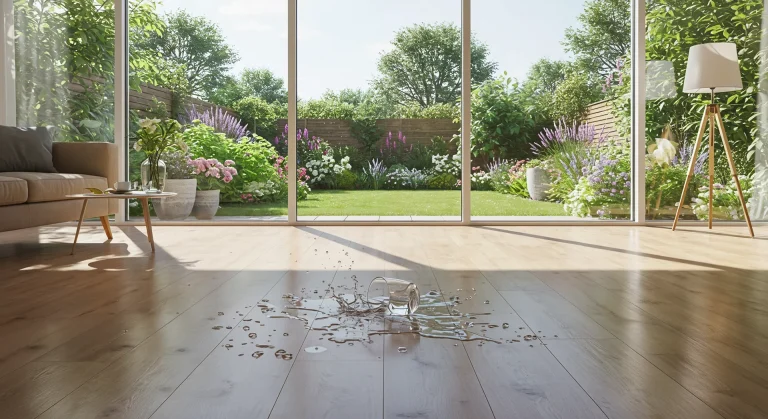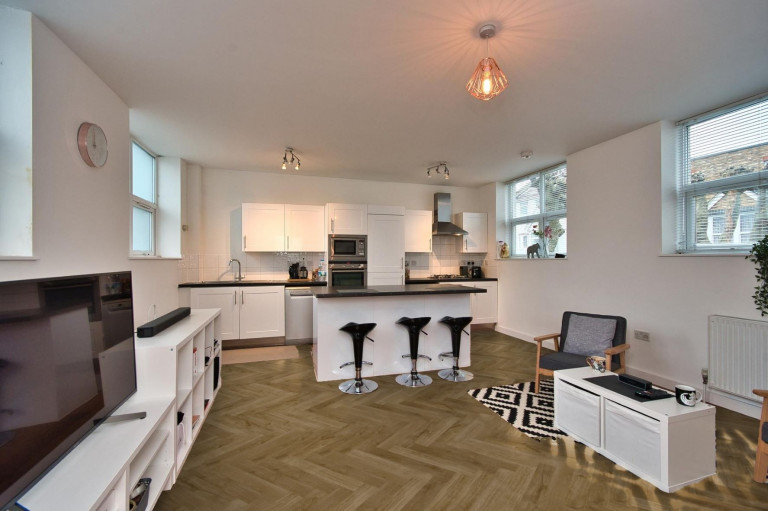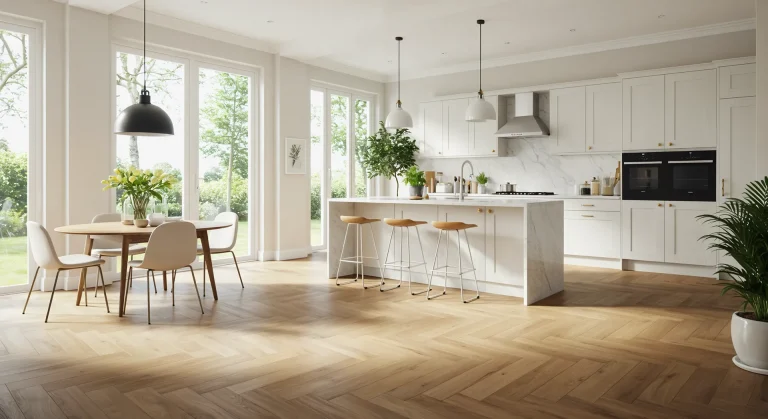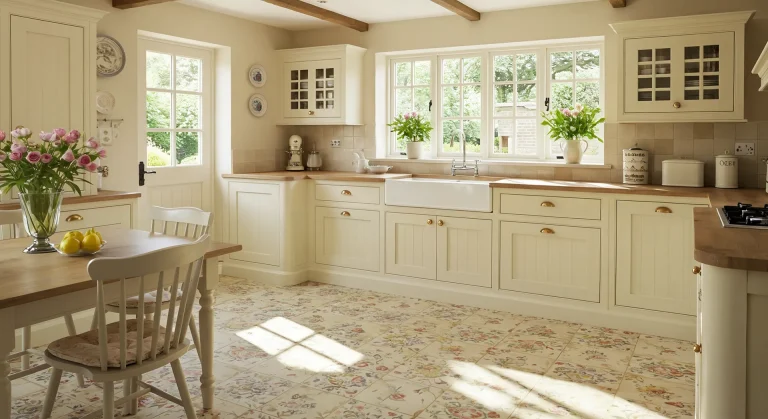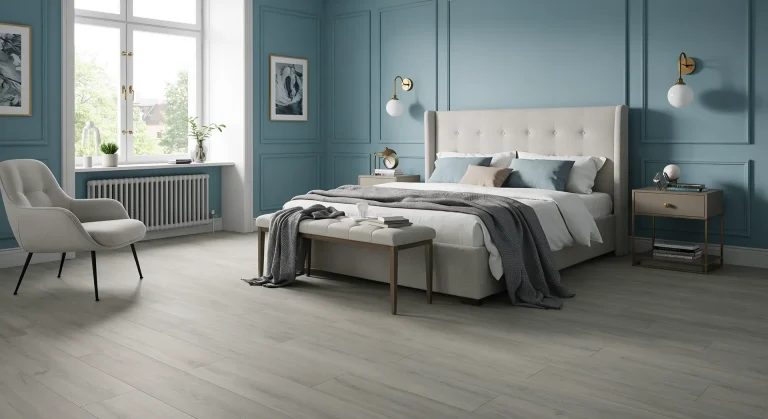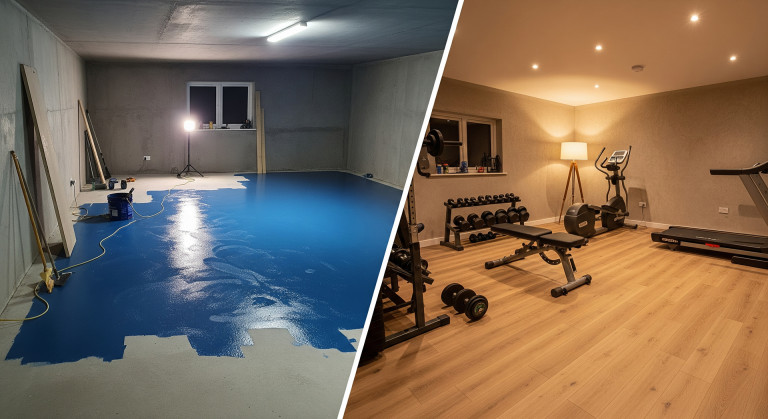Searching for how to clean laminate flooring? Laminate is a stylish, durable, and relatively low-maintenance choice popular in UK homes and businesses. While designed to handle daily life, understanding how to clean laminate flooring correctly is essential to keep it looking great and prevent damage. Improper cleaning techniques, especially concerning moisture, can harm laminate surfaces over time.
This guide provides everything you need to know for effective laminate floor cleaning and maintenance, ensuring your floors stay beautiful for years to come.
Jump to Section:
- Preventing Damage: Key to Easier Laminate Floor Cleaning
- How to Clean Laminate Flooring: Routine Care
- How to Mop Laminate Flooring Safely
- How to Deep Clean Laminate Flooring
- How to Remove Stains When Cleaning Laminate Flooring
- How to Remove Scratches from Laminate Flooring
- Frequently Asked Questions on How to Clean Laminate Flooring
- Must-Have Products for Laminate Floor Care
Preventing Damage: Key to Easier Laminate Floor Cleaning
Laminate flooring is tough, but not indestructible. Implementing simple preventative habits is the first step in effective laminate floor care and makes the task of cleaning laminate flooring much simpler.
Dirt, grit, and pet hair act like sandpaper, causing micro-scratches. Daily sweeping or vacuuming (always use a soft-brush attachment or hard floor setting) is fundamental when considering how to clean laminate flooring long-term. Placing doormats at entrances significantly reduces tracked-in dirt.
Protect your floors from furniture by using felt pads under legs and placing area rugs in high-traffic zones. If you need to move furniture, always lift, don’t drag, to avoid scuffs – a crucial tip often overlooked in basic laminate cleaning.
Crucially for laminate, standing water is the enemy. Although laminate has a protective layer, moisture seeping into seams can cause warping or swelling. Wipe up spills immediately. This moisture sensitivity is a key factor differentiating how to clean laminate flooring from other floor types like vinyl.
How to Clean Laminate Flooring: Routine Care
A simple routine keeps laminate floors looking their best and is central to knowing how to clean laminate flooring properly.
Sweep or vacuum daily (using the correct soft attachment) to remove loose debris. This prevents scratches during foot traffic and subsequent mopping steps.
For regular laminate floor cleaning (e.g., weekly), use a damp mop, not a wet one. Microfibre mops work exceptionally well. Use plain water or a pH-neutral cleaner specifically designed and labelled safe for laminate floors. Never use abrasive cleaners, oil soaps, wax-based products, or harsh chemicals like bleach, as these can damage the protective layer or leave a dulling residue. This is a vital part of cleaning laminate correctly. Dry the floor immediately after damp mopping if any moisture remains.
How to Mop Laminate Flooring Safely
Because laminate is moisture-sensitive (not waterproof), mastering how to clean laminate flooring with a mop requires care. Using too much water is the most common mistake.
- Choose the Right Cleaner: Use water or a pH-neutral, laminate-safe cleaner. Avoid vinegar solutions long-term, as acidity can potentially affect the finish over time.
- Use Minimal Water: Wring your microfibre mop out thoroughly until it is only slightly damp. A spray mop designed for laminate can be excellent for controlling moisture.
- Mop Direction: Work in the direction of the planks to minimise streaks.
- Rinse (If Necessary): If using a traditional mop and cleaner that requires rinsing, use a separate bucket with clean water and again, wring the mop out thoroughly.
- Dry: Go over the floor with a dry microfibre cloth or mop immediately after washing to lift any remaining moisture. Never let water pool or sit on the floor.
How to Deep Clean Laminate Flooring
Over time, even with regular laminate floor cleaning, residue or stubborn grime can build up, making the floor look dull. Deep cleaning every few months restores its appearance.
Start by clearing the area and vacuuming thoroughly. Use your laminate-safe pH-neutral cleaner with a well-wrung damp mop. Focus on areas that look particularly dirty or hazy. If you suspect cleaner residue is causing dullness, go over the floor again with a separate clean damp mop using only water, then dry thoroughly.
For tricky spots encountered during this deeper laminate cleaning, you might gently use a soft cloth with a tiny amount of rubbing alcohol (test in a hidden spot first!) but avoid scrubbing. Never use abrasive pads.
How to Remove Stains When Cleaning Laminate Flooring
Part of knowing how to clean laminate flooring involves dealing with occasional stains. Laminate is stain-resistant, but act quickly on spills..
- Food, Drink, Grease: Wipe gently with a damp microfibre cloth, perhaps using a drop of your pH-neutral laminate cleaner if needed.
- Scuff Marks: Often rub off with a clean microfibre cloth, a pencil eraser, or a very gently used melamine sponge (magic eraser). Excessive pressure can dull the finish.
- Tough Stains (Ink, Nail Polish, Marker): These require extreme caution. Before attempting to use strong solvents like rubbing alcohol or acetone (nail polish remover), consult your specific laminate flooring manufacturer’s stain removal guide. These chemicals can permanently damage or discolour the laminate’s protective layer or printed pattern, and using them may void your warranty. If the manufacturer explicitly approves such a method for specific stains on your type of laminate, only then should you proceed with utmost care: carefully dab (do not rub) the very center of the stain with a soft cloth barely moistened with the exact solvent recommended. Always test in a hidden, inconspicuous area first. Use the absolute minimal amount necessary. Rinse the spot immediately afterwards with a clean damp cloth, and dry thoroughly. Work meticulously to avoid spreading the stain or letting the solvent sit on the surface.
How to Remove Scratches from Laminate Flooring
While scratch-resistant, minor marks can happen. Addressing these is part of good laminate floor care.
For light surface scratches, try buffing gently with a microfibre cloth. If slightly more visible, use a laminate floor repair kit with wax filler sticks or touch-up markers matched to your floor’s colour. Follow the kit instructions carefully.
Using floor polish is generally not recommended for laminate as it doesn’t absorb it and can create buildup. For deep scratches or damage penetrating the top layer, the only effective solution is usually to replace the damaged plank, which is often feasible with click-lock laminate systems.
Frequently Asked Questions on How to Clean Laminate Flooring
When cleaning laminate flooring, can you use a steam mop?
Absolutely not. Steam injects heat and moisture between the planks and layers, which will likely cause irreparable damage like warping, swelling, and edge peeling. This is a critical “don’t” when learning how to clean laminate flooring.
What’s the best cleaner to use when cleaning laminate flooring?
The safest choice is a pH-neutral cleaner specifically labelled for use on laminate floors. Water alone (on a damp mop) is often sufficient for light cleaning. Avoid oil soaps, waxes, polishes, bleach, ammonia, vinegar (except potentially for very occasional spot cleaning), and abrasive cleaners.
How often does laminate flooring need cleaning?
Daily sweeping/vacuuming is recommended. Damp mopping frequency depends on traffic – perhaps weekly for busy areas, less often otherwise. Deep clean every few months or as needed. Consistent laminate floor cleaning prevents excessive buildup.
How do you remove sticky residue when cleaning laminate?
First, try gently rubbing with a damp microfibre cloth. If needed, add a drop of mild dish soap to the damp cloth or use your pH-neutral laminate cleaner. For very stubborn sticky spots, always check your laminate flooring manufacturer’s recommendations before using chemicals like rubbing alcohol, as they might damage the finish or void your warranty. If approved by the manufacturer for your specific floor, test cautiously in a hidden area first by dabbing gently with a soft cloth. Remember to avoid scraping the floor with sharp objects.
Must-Have Products for Laminate Floor Care
Using the right tools makes how to clean laminate flooring easier and safer:
- A pH-neutral, laminate-safe floor cleaner.
- Microfibre mops (one for damp cleaning, one for drying).
- A vacuum with a soft brush head or hard floor setting.
- Felt furniture pads.
- Doormats.
- (Optional) Laminate repair kit (wax/markers) for minor scratches.
Conclusion
Mastering how to clean laminate flooring correctly revolves around routine dirt removal and, crucially, minimising moisture exposure. By using gentle, laminate-safe cleaners, damp (not wet) mopping techniques, and taking preventative measures, you can easily maintain the stylish appearance of your floor. Remember the key takeaways for proper laminate floor cleaning: sweep often, mop damp, clean spills immediately, and never use steam mops or harsh/abrasive products. Following these steps, alongside your manufacturer’s specific guidance, will keep your UK laminate floors looking great for years.

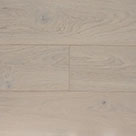 Light
Light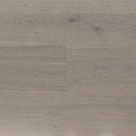 Grey
Grey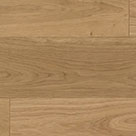 Natural
Natural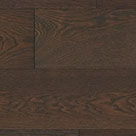 Dark
Dark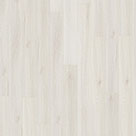 White
White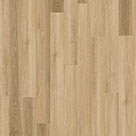 Light
Light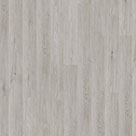 Grey
Grey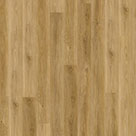 Natural
Natural Dark
Dark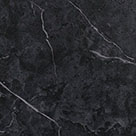 Black
Black

